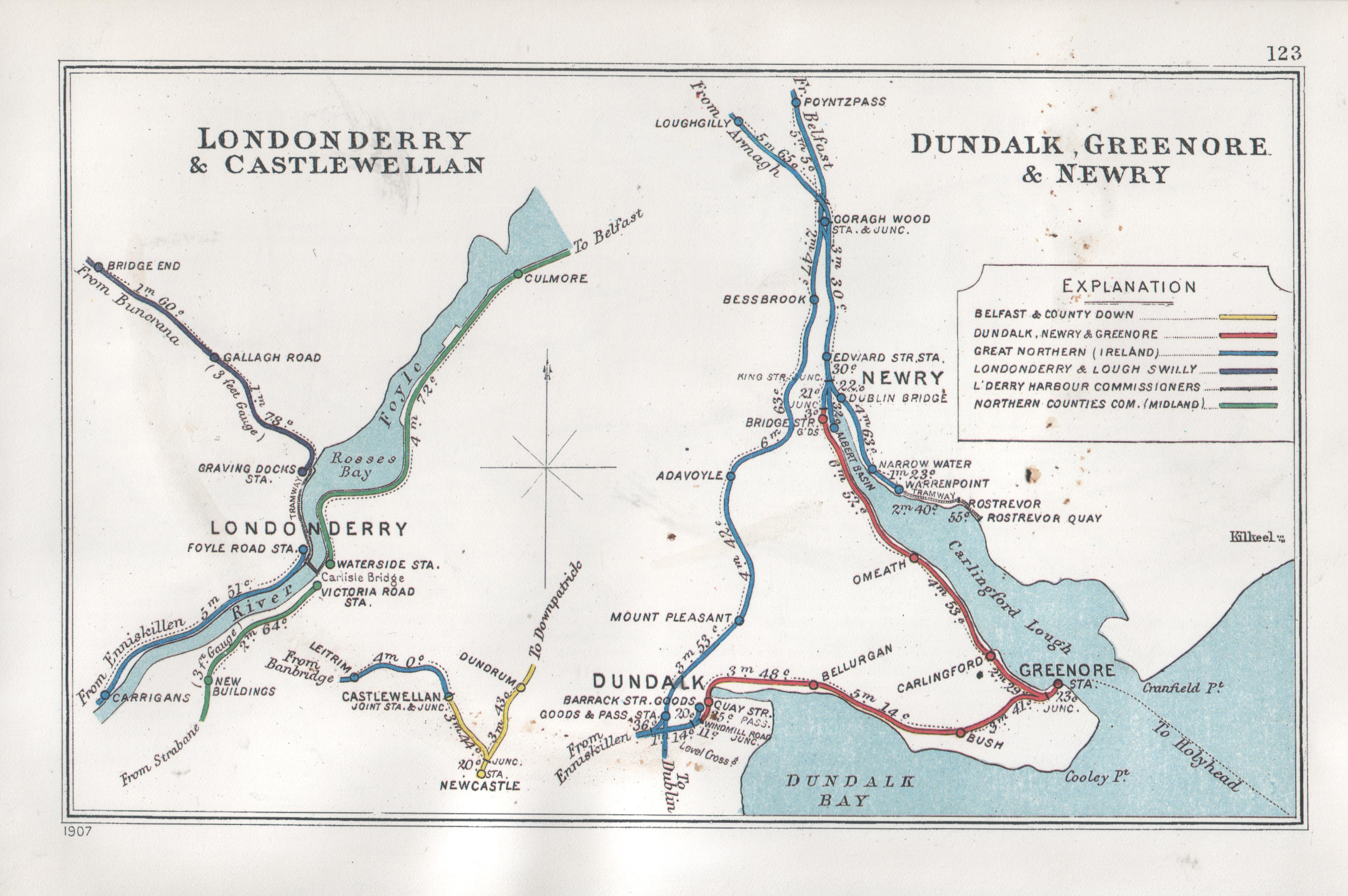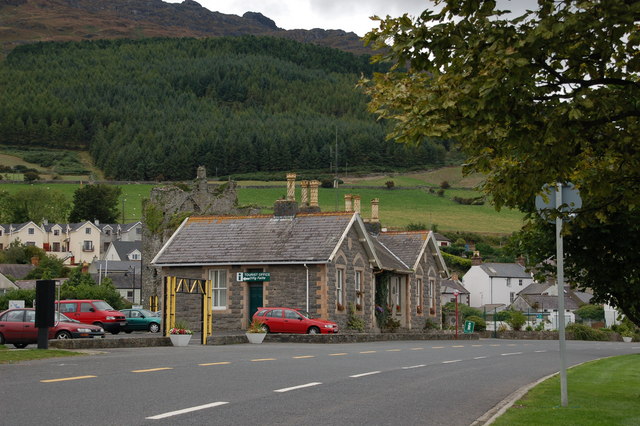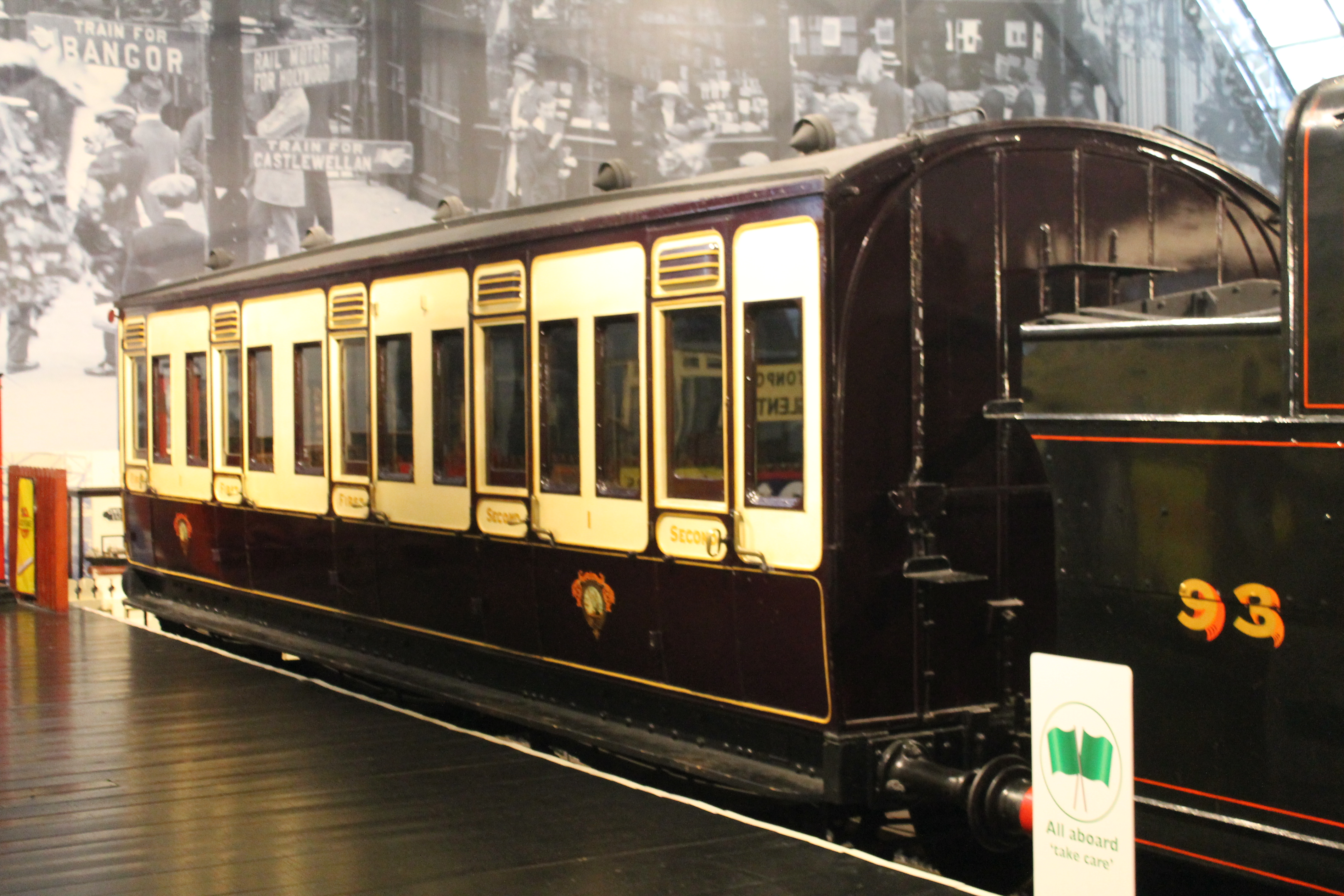Dundalk, Newry And Greenore Railway on:
[Wikipedia]
[Google]
[Amazon]

 The Dundalk, Newry and Greenore Railway (DNGR, DN&GR) was an Irish gauge () railway in Ireland. It was conceived in the 1860s to provide a link between the towns in its title and the
The Dundalk, Newry and Greenore Railway (DNGR, DN&GR) was an Irish gauge () railway in Ireland. It was conceived in the 1860s to provide a link between the towns in its title and the
 One six-wheeled coach, DNGR No. 1 built in 1909, a composite with a coupé compartment, has been preserved at the
One six-wheeled coach, DNGR No. 1 built in 1909, a composite with a coupé compartment, has been preserved at the
Dundalk, Newry and Greenore Railway history
- irishrailwayana.com {{Authority control Early British railway companies Closed railways in Ireland Closed railways in Northern Ireland Railway lines opened in 1873 Railway lines closed in 1951 Irish gauge railways London and North Western Railway

 The Dundalk, Newry and Greenore Railway (DNGR, DN&GR) was an Irish gauge () railway in Ireland. It was conceived in the 1860s to provide a link between the towns in its title and the
The Dundalk, Newry and Greenore Railway (DNGR, DN&GR) was an Irish gauge () railway in Ireland. It was conceived in the 1860s to provide a link between the towns in its title and the London and North Western Railway
The London and North Western Railway (LNWR, L&NWR) was a British railway company between 1846 and 1922. In the late 19th century, the L&NWR was the largest joint stock company in the United Kingdom.
In 1923, it became a constituent of the Lo ...
port at Greenore
Greenore () is a village, townland and deep water port on Carlingford Lough in County Louth, Ireland.
History
A lighthouse was built on Greenore Point in 1830.
Several decades later, the Dundalk and Greenore Railway Act of 1863 authorised th ...
, from where a ferry service operated to Holyhead
Holyhead (,; cy, Caergybi , "Cybi's fort") is the largest town and a community in the county of Isle of Anglesey, Wales, with a population of 13,659 at the 2011 census. Holyhead is on Holy Island, bounded by the Irish Sea to the north, and is ...
. It was opened between Greenore and Dundalk
Dundalk ( ; ga, Dún Dealgan ), meaning "the fort of Dealgan", is the county town (the administrative centre) of County Louth, Ireland. The town is on the Castletown River, which flows into Dundalk Bay on the east coast of Ireland. It is h ...
in 1873 and extended to Newry
Newry (; ) is a city in Northern Ireland, divided by the Clanrye river in counties Armagh and Down, from Belfast and from Dublin. It had a population of 26,967 in 2011.
Newry was founded in 1144 alongside a Cistercian monastery, althoug ...
in 1876. The company operated a hotel at Greenore.
Ownership
The L&NWR owned the railway and at first provided its locomotives and rolling stock, with the locomotives coming from itsCrewe Works
Crewe Works is a British railway engineering facility located in the town of Crewe, Cheshire. The works, which was originally opened by the Grand Junction Railway in 1840, employed around 7,000 to 8,000 workers at its peak. In the 1980s, a lot ...
. The railway passed to the London, Midland and Scottish Railway
The London, Midland and Scottish Railway (LMSIt has been argued that the initials LMSR should be used to be consistent with LNER, GWR and SR. The London, Midland and Scottish Railway's corporate image used LMS, and this is what is generally u ...
in 1923 but an agreement was reached in 1933 for the line to be worked by the Great Northern Railway. Because the partition of Ireland
The partition of Ireland ( ga, críochdheighilt na hÉireann) was the process by which the Government of the United Kingdom of Great Britain and Ireland divided Ireland into two self-governing polities: Northern Ireland and Southern Ireland. I ...
placed an international frontier across the DN&G's Greenore – Newry line, it was not absorbed into either the Great Southern Railways
The Great Southern Railways Company (often Great Southern Railways, or GSR) was an Irish company that from 1925 until 1945 owned and operated all railways that lay wholly within the Irish Free State (the present-day Republic of Ireland).
The p ...
in 1925 or the Ulster Transport Authority
The Ulster Transport Authority (UTA) ran rail and bus transport in Northern Ireland from 1948 until 1966.
Formation and consolidation
The UTA was formed by the Transport Act 1948, which merged the Northern Ireland Road Transport Board (NIRTB ...
in 1948.
Closure
The line was closed on 31 December 1951 and was dissolved in 1957 by act of consent.Preservation
 One six-wheeled coach, DNGR No. 1 built in 1909, a composite with a coupé compartment, has been preserved at the
One six-wheeled coach, DNGR No. 1 built in 1909, a composite with a coupé compartment, has been preserved at the Ulster Folk and Transport Museum
The Ulster Folk Museum and the Ulster Transport Museum are situated in Cultra, Northern Ireland, about east of the city of Belfast. The Folk Museum endeavours to illustrate the way of life and traditions of the people in Northern Ireland, past ...
, Cultra
Cultra ( - ) is an affluent residential neighbourhood near Holywood, County Down, Northern Ireland. It is part of Greater Belfast. It is in the Ards and North Down Borough Council area.
Cultra is home to the Royal North of Ireland Yacht Cl ...
.
Consideration was given to the preservation of locomotive No.1 ''Macrory'' but, in the end, no locomotives were preserved. It is believed that this was because of an ill-informed belief among those in charge of its fate that the locomotive was of a different track gauge to the rest of Ireland, due to the fact that it was built and owned by a British company, although this was not the case. All of the locomotive nameplates have been preserved.
However, a GNR 2-4-2T JT class locomotive, No. 93, which worked on the DNGR line under GNR operation, has also been preserved and is displayed with the DNGR coach in Cultra.
See also
*Locomotives of the Dundalk, Newry and Greenore Railway
The locomotives of the Dundalk, Newry and Greenore Railway were all 0-6-0ST ( saddle tanks), with inside cylinders, to the designs of LNWR Chief Mechanical Engineer, John Ramsbottom, the first three locomotives being built by the LNWR Crewe Work ...
*Newry, Warrenpoint and Rostrevor Railway
The Newry, Warrenpoint and Rostrevor Railway (NW&RR) was a former railway line linking Newry and the port of Warrenpoint on the Carlingford Lough inlet in Ireland, and the company operating it. The railway was absorbed into the Great Northern ...
- which ran on the other side of Carlingford Lough
References
Further reading
*External links
Dundalk, Newry and Greenore Railway history
- irishrailwayana.com {{Authority control Early British railway companies Closed railways in Ireland Closed railways in Northern Ireland Railway lines opened in 1873 Railway lines closed in 1951 Irish gauge railways London and North Western Railway